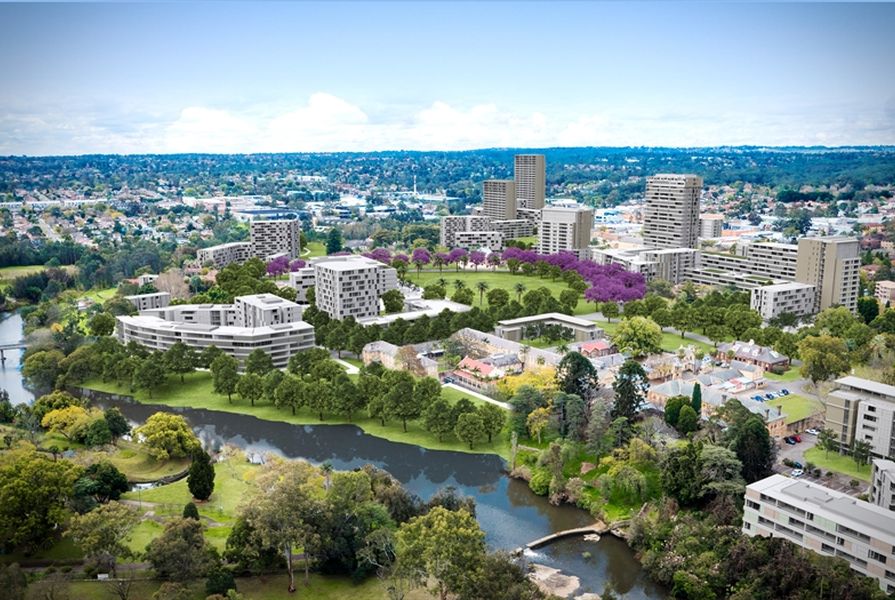Back in 2004 when I coined the term Parramatta Female Factory Precinct (PFFP), little was known of the precinct’s historic institutions, the Parramatta Female Factory and the Roman Catholic Orphan School. Located north of Old Government House across the Parramatta River in Fleet Street, these institutional complexes form part of what Urban Growth NSW identify as the Cumberland Precinct in the Parramatta North Urban Renewal (PNUR) plan.
Together, they bear witness to the evolution of a system of care for women, children and the mentally ill from early colonial times to the present day. First came the Female Factory, built in 1821 to provide refuge and employment for unassigned convict women and after 1847 as an Invalid and Lunatic Asylum, renamed in 1983 to Cumberland Hospital. In 1844, Australia’s first government owned Roman Catholic orphanage was built on land adjacent to the Female Factory. The orphanage was re-purposed as the Girls Industrial School (Parramatta Girls Home) in 1887 and operated as a child welfare institution until 1980, when it was re-purposed as the Norma Parker Detention Centre for Women. In 2010, the Norma Parker Centre was decommissioned and the site returned to the Lands Authority.
The state government now plans to spend around $100 million refurbishing these historic sites with a contribution of further funds by developers, who hope to build almost 4,000 new dwellings in apartment towers up to 30 storeys high and a 4,000 square-metre village centre in and around the Cumberland Precinct. With these funds combined, the preservation and activation of the sites would be assured, but some locals are adamantly opposed to the development.
What then are the implications if development does not proceed? This would suggest that the historic sites would fall further into decay; that they would remain off-limits to the public, locking away 200 years of one of Australia’s most significant histories.
As one who has long campaigned for the preservation and appropriate utilization of the Precinct’s historic institutions, the Parramatta North Urban Renewal plan cannot come soon enough. My connection to this site goes back to 1970, when at the age of 15 I spent time in the Parramatta Girls Home. Back then, Fleet Street was a place that only those obliged to attend these institutions – including the Parramatta Gaol – visited. In fact, to be seen in the vicinity of Fleet Street was to suggest an association with immorality, insanity or criminality. That’s how deep the taint of institutionalization had embedded itself in the psyche of Parramatta. For me, even returning to this site took incredible courage. Now, more than 10 years on, I still witness this struggle in the women who return to confront a very sad part of their lives.
My quest to make change, to reshape a better future for this site, comes from a desire that the rampant institutionalization of people never happens again. This is a view shared by all who have experienced this reality – and no doubt still festers in the minds of refugees imprisoned in detention centres.
It is for these reasons that I am saddened to see so much opposition to the Urban Renewal plan. Certainly, I agree that communities have the right to question, to challenge development, but I disagree with the tactics employed. These tactics include the spreading of misinformation: that the Female Factory or indeed the former orphanage buildings will be demolished, or that development poses a threat to the integrity of these historic sites, or to Old Government House.
At present, these historic buildings that speak directly to our Australian identity are off-limits to the public. During footy season, they are further degraded, becoming a carpark for footy fans. I see the potential to create a place where people from a diversity of lifestyles, age groups, ethnicities and economic statuses can interact daily in an environment that activates this history and provides much-needed housing – including affordable housing, emergency housing for women fleeing domestic violence and accommodation for people reliant on services provided by Cumberland and Westmead Hospitals.
Where presently a collection of neglected post-war cottages, a nursing home, residential clinic and a former infant’s school are located at the gateway to the precinct, I see the potential to create exemplary architectural living spaces that in time will be as valued as the historic sandstone buildings.
Where weeds reclaim the empty and near derelict buildings and grounds of the former Orphanage/Girls Home I see the potential to create a dedicated memorial garden to its forgotten children, and an interpretation centre where past injustices could be used to inform contemporary human rights issues as Australia’s first Site of Conscience.
Where once the Female Factory Cell Block Extension yard was used to control and punish women and segregate the mentally ill it could now be a place that nurtures creativity and connection with a new building that could play a key role in liberating the human story that resides within these walls.
Weed-ridden grounds and neglected buildings are just that; without investment in their future restoration and activation, and the revitalized energies of daily human interaction connecting past to present, these places will simply remain graveyards of a bygone era.
Crucially, the very people who occupied these institutions should be given every opportunity to participate in determinations for the sites, not just those who have rather romanticised views of sandstone buildings and river settings. This sort of approach is unacceptable at other places of human suffering and trauma.
Surely it is time for change, for conversation, compromise and risk-taking; time to put aside unfounded threats and challenge conservative thinking to imagine a better future.

















